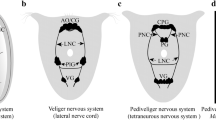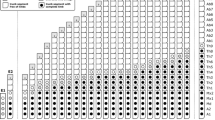Summary
in order to determine the time and site of origin and the final location of various cell groups in the spinal cord, tadpoles of Xenopus laevis, ranging from stage 48 to stage 56 were treated with tritiated thymidine and sacrified at various stages from 49 to 66 (stages according to Nieuwkoop and Faber (1967).
From the poorly developed matrix at stage 48–49 not only ventral horn cells, but also neuroblasts of the intermediate zone and the dorsal horn arise. Both the matrix and the ventricle expand in a dorsal direction. From the well-developed matrix at stage 54, in which the mitotic activity is almost exclusively confined to its dorsal part, mainly cells of the dorsal horn develop. However, this later-stage matrix also gives rise to a considerable number of neuroblasts, which become located in the central parts of the intermediate zone and the ventral horn.
Generally the later-born cells come to lie dorsomedially to the older ones. The neuroblasts of the lateral motor column, however, migrate through and settle ventrolaterally to their predecessors.
Our observations do not support the basal plate-alar plate concept of His (1893).
Similar content being viewed by others
References
Berry M, Rogers AW (1965) The migration of neuroblasts in the developing cerebral cortex. J Anat 99:691–709
Ebbesson SOE (1976) Morphology of the spinal cord. In: Llinás R, Precht W (eds) Frog neurobiology. Springer, Berlin Heidelberg New York, pp 679–706
Fujita S (1964) Analysis of neuron differentiation in the central nervous system by tritiated thymidine autoradiography. J Comp Neurol 122:311–327
Hamburger V (1948) The mitotic patterns in the spinal cord of the chick embryo and their relation to histogenetic processes. J Comp Neurol 88:221–283
Hamburger V (1977) The developmental history of the motor neuron. Neurosci Res Progr Bull Suppl 15:1–37
His W (1893) Vorschläge zur Einteilung des Gehirns. Arch Anat Physiol Anat Abt 172–180
Hollyday M, Hamburger V (1977) An autoradiographic study of the formation of the lateral motor column in the chick embryo. Brain Res 132:197–208
Kanemitsu A (1970) Cytoarchitecture de la moelle épinière chez le poulet envisagée du point de vue du développement. Proc Jpn Acad 46:77–82
Kanemitsu A (1972) Etude quantitative de la neurogénèse dans la moelle épinière chez le poulet par l'autoradiographie. Proc Jpn Acad 48:758–763
Kanemitsu A (1977) Chick cervical and thoracic spinal cord at stages 14–30 studied by 3H-thymidine autoradiography. Adv Neurol Sci (Tokyo) 212:204–217
Kanemitsu A (1979) Developmental sequence among spinal neurons. In: Tsubaki T, Toyokura Y (eds) Amyotrophic lateral sclerosis. University of Tokyo Press, Tokyo, pp 387–403
Langman J, Haden CC (1970) Formation and migration of neuroblasts in the spinal cord of the chick embryo. J Comp Neurol 138:419–431
Nieuwkoop PD, Faber J (1967) Normal table of Xenopus laevis (Daudin). North Holland Publ Co, Amsterdam
Nornes HO, Carry M (1978) Neurogenesis in spinal cord of mouse: an autoradiographic analysis. Brain Res 159:1–16
Nornes HO, Das GD (1974) Temporal pattern of neurogenesis in spinal cord of rat. I. An autoradiographic study-time and sites of origin and migration and settling patterns of neuroblasts. Brain Res 73:121–138
Pollack ED (1969) Normal development of the lateral motor column in the brachial cord in Rana pipiens. Anat Rec 163:111–120
Pollack ED, Kollros JJ (1975) Cell migration into the “established” lateral motor column in Rana pipiens larvae. II. Lumbosacral spinal cord and comparative aspects. J Exp Zool 192:299–306
Prestige MC (1973) Gradients in time of origin of tadpole motoneurons. Brain Res 59:400–404
Sims TJ, Vaughn JE (1979) The generation of neurons involved in an early reflex pathway of embryonic mouse spinal cord. J Comp Neurol 183:707–720
Thors F, Kort EJM de, Nieuwenhuys R (1982) On the development of the spinal cord of the clawed frog, Xenopus laevis. I. Morphogenesis and histogenesis. Anat Embryol 164:427–441
Wenger EL (1950) An experimental analysis of relations between parts of the brachial spinal cord of the embryonic chick. J Exp Zool 114:51–86
Author information
Authors and Affiliations
Rights and permissions
About this article
Cite this article
Thors, F., de Kort, E.J.M. & Nieuwenhuys, R. On the development of the spinal cord of the clawed frog, Xenopus laevis . Anat Embryol 164, 443–454 (1982). https://doi.org/10.1007/BF00315764
Accepted:
Issue Date:
DOI: https://doi.org/10.1007/BF00315764




